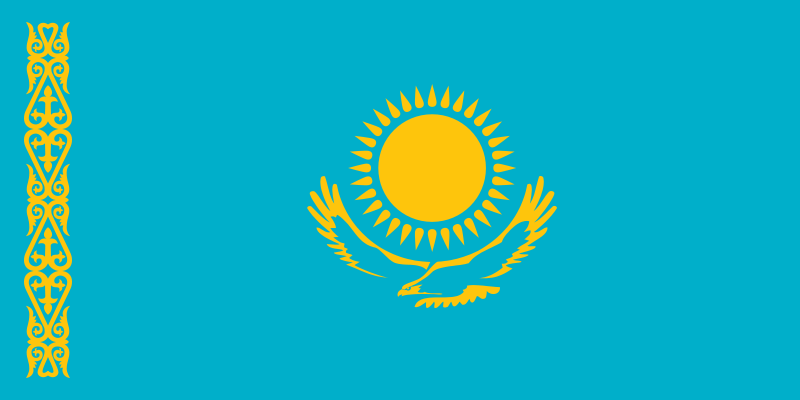
Kazakhstan’s geographical and geopolitical position has played a vital role in promoting the country’s development. Located in the center of Eurasia, Kazakhstan has found itself at the crossroads of the world’s most ancient civilizations and trade routes. It has been a land of social, economic, and cultural exchange between East and West, North and South, and major Eurasian nations. At different stages of its history, various states emerged, developed, and contributed to the land that became today’s Kazakhstan.
A thousand years before the Christian era, the nomadic Skythian-Saka civilization prospered on the Central Asian steppes. Many of their cultural monuments have survived, including impressive tools and everyday items made in gold and bronze, extracted from ancient burial mounds. Another worthy extraction, the royal tomb of the Golden Warrior Prince of the Saka civilization, was found in the ancient town of Issyk and is famous for its integrity, beauty, elegance, and craftsmanship. This cultural treasure’s motifs have become the basis of the modern Monument of Independence, erected in Almaty in the early 1990s.
In later centuries, the steppes were home to a powerful state formed by the Huns, whose empire greatly influenced the geopolitical map of that time. In fact, the Great Roman Empire was eventually destroyed by the blows of Attila the Hun’s daring warriors.
Later, the Huns were replaced by Turkic tribes who founded several large states known as kaganats, stretching from the Yellow Sea in the East to the Black Sea in the West. These states were distinguished by a progressive culture, not only based on a nomadic economy but also on an oasis urban culture with rich trade and handicraft traditions. During this time, cities and caravanserais (roadside inns) were founded in the oases of Central Asia, the territory of South Kazakhstan, and Central Asia, and stood along the famous trade route known as the Great Silk Road which connected Europe and China. The route along the Syr Dariya River to the Aral Sea and the South Urals, as well the Sable Road from South Western regions of Siberia through Central Kazakhstan and the Altai region, were also very important. It was through trade on the Sable Road that the Middle East and Europe were supplied with expensive furs. Major cities and trade centers founded on these routes included:
- Otrar (Farab)
- Taraz
- Kulan
- Yassy (Turkestan)
- Sauran
- Balasagun
 The Great Silk Road not only stimulated the development of trade, it also became a conduit for new scientific and cultural ideas. For example, the great philosopher Al-Farabi (870-950) was largely influenced by the culture of the trade routes. Born in the Farab district, Al-Farabi was dubbed “the Second Teacher,” after Aristotle, for his profound findings in the following fields:
The Great Silk Road not only stimulated the development of trade, it also became a conduit for new scientific and cultural ideas. For example, the great philosopher Al-Farabi (870-950) was largely influenced by the culture of the trade routes. Born in the Farab district, Al-Farabi was dubbed “the Second Teacher,” after Aristotle, for his profound findings in the following fields:
- Philosophy
- Astronomy
- Musical theory
- Mathematics
In the 11th century, the outstanding scholar of Turkic philology, Mahmud Kashgari, created the three-volume Dictionary of Turkic Dialects, dedicated to Turkic folklore and literature heritages. Around the same time, Yusup Balasaguni, a famous poet and philosopher from Balasagun, wrote Kutaglu Bilig (A Knowledge that Brings Happiness) which is thought to have played an important role in the development of many modern conceptions, including:
- Sociology
- Politics
- Ethics
Part of the cultural legacy of that period is the elegant urban architecture. Some of the best preserved examples are the mausoleums of:
- Arystan Baba
- Sufi Hodja Akhmet Yassaui in Turkestan
- Aisha Bibi in Taraz.
Apart from this, the most ancient nomads of the region invented the yurt, a dome-shaped portable house made from wood and felt, ideal for an itinerant life.
Years later, in 1221, Mongolian tribes of Genghis Khan conquered Central Asia and added their own culture and values to the increasingly complex society of the region.
By the second half of the 15th century a process of consolidation had begun among the peoples of the Central Asian steppe. Derived from the various ethnic and cultural identities, this process was drawn together by a common world view and lifestyle. The first Kazakh khanates emerged at this time, and by the first half of the 16th century, the formation of a single Kazakh nation was completed. The word “Kazakh” in the old Turkic language meant “free” or “independent,” perfectly defining the people who had been yearning for their own independent state.
In the 17th and 18th centuries, the nomadic Jungar tribes, directed by the Chinese Bogdykhans, started a large scale war against the Kazakh khanate. Fortunately, the people escaped total capture and physical annihilation, due to a variety of factors:
- The courage of the “batyrs” (knights)
- The decisiveness of the Kazakh leader, Ablai Khan
- The diplomatic skills of the Kazakh ‘biys’ (sages), Tole Bi, Kazdausty Kazybek Bi, and Aiteke Bi
- The self sacrifice of the people.
The Kazakhs were never able to fully recover from the war or establish themselves as a powerful military force; therefore, they sought the protection of the Russian Empire and lost sovereignty in 1871. For a time, the fate of Kazakhstan was tied to that of the Russian State and its peoples, as well as the European model of social development.
After the 1917 revolution, Soviet power was established in Kazakhstan, and the people suffered greatly. Due to the forced collectivization in the 1930s, hunger caused the death of 1.5 million Kazakhs, more than 40 percent of the nation. Many of those who survived fled to China, while others, mostly gifted intellectuals, were repressed and often killed by the Soviet regime. In protest, Kazakhs took to the streets on December 17, 1986, indicating to the world that the reign of the once powerful Soviet Union was soon coming to an end.
Five years later, Kazakhstan proclaimed its independence on December 16, 1991, and Nursultan Nazarbayev was democratically elected the first President of the country.
Ethnic Composition
As of 2006, the ethnic composition of Kazakahstan is comprised of:
- Kazakh, 59.2 percent
- Russian, 25.6 percent
- Ukrainian, 2.9 percent
- Uzbek, 2.9 percent
- Uyghur, 1.5 percent
- Tatar, 1.5 percent
- German 1.4 percent
Ethnic Movement
In 1991, the Kazakh and Russian populations were generally equal. However, between 1989 and 1999 approximately 1.5 million Russians and 500,000 Germans (more than half the German population) left Kazakhstan. This disconcerting mass exodus led to concern over the loss of the technical expertise provided by these ethnic groups. Unfortunately, these trends have continued, evidenced by Germans falling from almost six percent in 1989 to a current 1.5 percent and Russians now forming only a quarter of the current overall population.
Clearly, Kazakhstan is one of the rare countries in which the national ethnicity has not always been the majority. In 1994, eight of the country's eleven provinces had Slavic population majorities, leaving only three provinces with a Kazakh majority. In fact, even the former capital, Almaty, had a European majority. Overall, the 1994 population consisted of the following groups:
* Kazakh, 44 percent
* Russian, 36 percent
* Ukrainian, 5 percent
* German, 4 percent
* Tatars and Uzbeks, 2 percent each
* Azerbaijanis, Uygurs, and Belarusians, 1 percent each
* Ninety other nationalities, 4 percent.
Kazakhstan's ethnic composition is the driving force behind much of the country's political and cultural life. Though the Republic has a variety of ethnicities, the majority can be broken down into two main groups, the Kazakhs and the "Russian-speakers"(Russians, Ukrainians, Germans, and Belarusians). To the Russians, mostly living in northern Kazakhstan, it is an extension of the Siberian frontier and a product of Russian and Soviet development. Roughly 38 percent of Kazakhstan’s Russian population was born outside the Republic, while most of the remaining majority are second-generation Kazakhstan citizens. In addition, further Russian movement occurred when the capital city of Almaty was moved to Astana; the Kazakh population moved northward and Russian-dominated northern provinces were absorbed into the Kazakhstan state.










